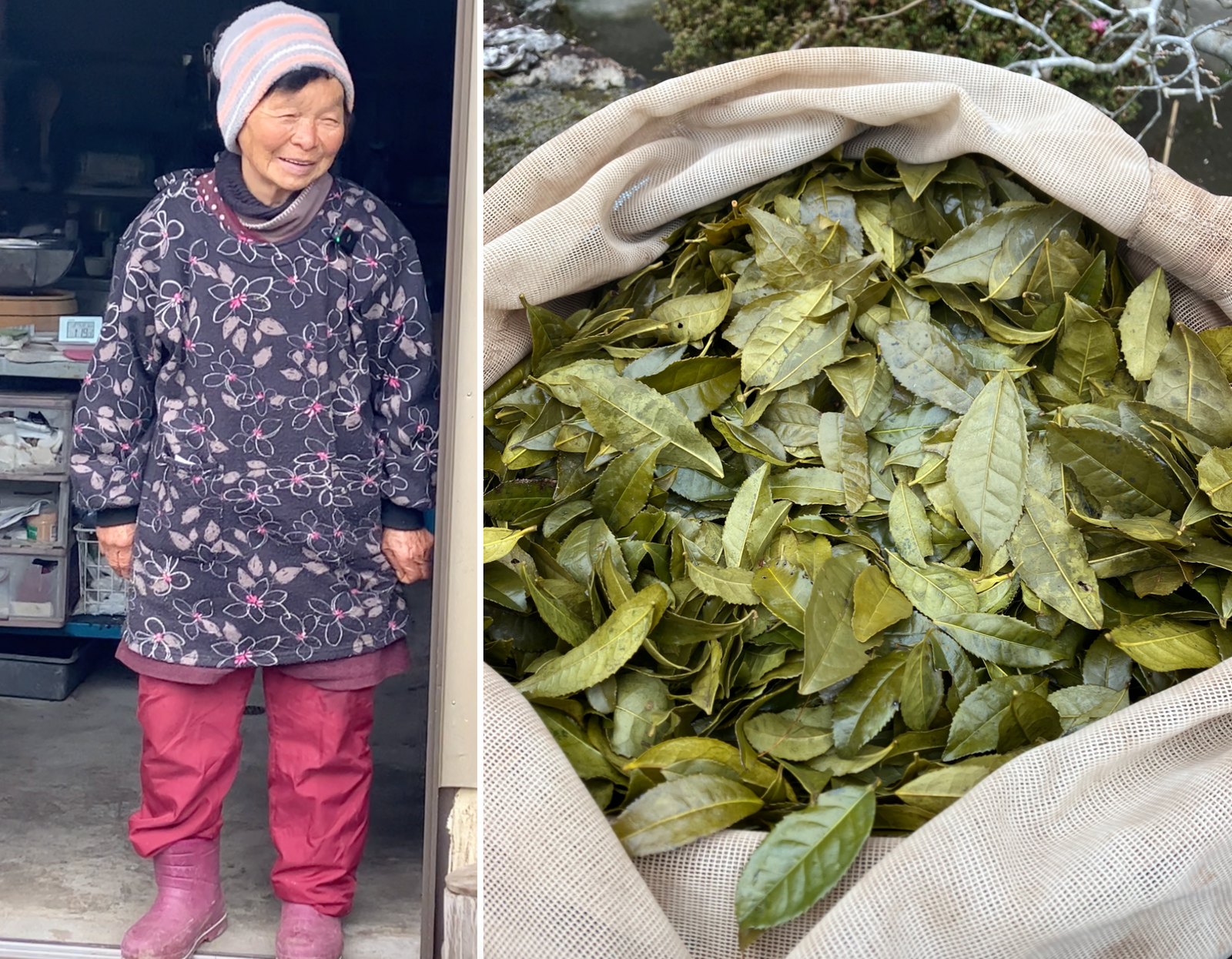2月3日と4日、徳島県最南端に位置する87歳の寒茶農家、石本明美さんを訪ねました。寒茶の製造工程については、最近の記事( 宍喰寒茶の作り方)で詳しくご紹介しています。今回は、石本さんのお話をさらに詳しく伺い、今回の旅で得た情報とその後の調査で得た情報を織り交ぜながら、お話を伺いたいと思います。
「かんちゃばあちゃん」
明美さんは、徳島県と高知県の境に位置する海陽町宍喰町広域の小さな山村、郭村に住んでいます。海陽町は、海、サーフィン、その他のマリン関連のレクリエーション活動で知られています。郭村は、狭い山道(山に入るとほとんどが片側一車線)をアップダウンし、比較的急なカーブを曲がり、主に野根川に沿って約30分の距離にあります。
2日間、明美さんとお話させていただいただけでも、彼女がカンチャに情熱を注いでいることがよく分かりました。彼女は、自分以上にカンチャを愛する人に出会ったことがないと言っていました。だからこそ、村人やこの地域の人々は彼女を「 カンチャばあちゃん」(カンチャおばあちゃん)と呼んで愛情を込めているのです。
彼女が生涯懸命に働き続けてきたことが、私たちにもはっきりと伝わってきました。収穫したカンチャの葉を煮ている彼女のそばに座って、彼女はカンチャの季節はとても忙しいけれど、お茶作りに忙しくしていない時でも、草取り、田植え、稲刈り、その他農作業、そして夫の介護、家事、子育てなど、やらなければならないことがたくさんあると話してくれました。彼女は笑顔で、休むことなくいつも忙しくしているからと友達からからかわれることが多いと話してくれました(賢いハチドリのようなイメージが浮かびました)。

明美さんは徳島県郭村で生まれました。19歳で洋裁を学んでいた頃、両親の計らいで林業を営む男性と結婚し、2人の子供に恵まれました。明美さんは以前、「自分が望んで選んだ人生ではなかった」と語っています。興味深いことに、明美さんはかつて村の「道場」の運営も担当していたそうです。私たちは道場の中を見学させてもらいましたが、今でもとても綺麗できちんと整理整頓されていました。建物は白い壁で、片側には歌の歌詞が書かれています。私の理解では、郭村と野根川の四季の歌だそうです。明美さんに村の歌を歌ってもらうようお願いしたのですが、大勢の前で歌うのは恥ずかしいとのことでした。


結婚し、子育てを終えた頃、郭村は過疎化の波に見舞われ始めました。明美さんは、生まれ育ったこの地で何か新しい仕事ができないかと、ずっと考えていました。そんな時、自宅裏の棚田に自生する野生茶を栽培・販売したいという思いに至りました。これは明美さんにとって新たなスタートでした。自宅裏の土を耕し、野生茶の種を蒔き始めました。そして、後述する寒茶生産組合の人々の協力を得て、明美さんは53歳にして寒茶の商品化に成功したのです。
明美さんが茶農家になる以前から、この地域では寒茶が盛んに作られていました。日本各地で様々な種類の番茶が生産されていますが、中国から伝わった釜炒り茶の系統に属するものは近世に急速に広まった製法で、その起源は 江戸時代(1603年)以前には遡ることができません。一方、蒸す、煮る、乾燥させるという簡単な工程で保存できる(貯蔵・保存が可能な)お茶の製法はかなり古いと考えられています。これらの技術は中世以前にまで遡る可能性があります。そして、これらの番茶は四国各地で見つけることができます!

四国茶マップ、提供:Josh Linvers ( sommerier.com )。
カンチャ生産協会
石本明美氏は1986年に寒茶生産組合(日本語:寒茶生産組合)を設立しました。寒茶生産以前から、郭村の女性たちは積極的に活動していました。1972年には14人の女性が集まり、生活改善グループを設立しました。それ以来、郭村では山村の地理的条件を活かし、各家庭で調理される山菜の加工に関する研究が盛んに行われています。
その後、1986年に宍夷地域でカンチャを特産品にしようという動きが本格化し、カンチャ生産組合が結成されました。この運動の先頭に立ったのは明美さんで、当初は20名の農家が加盟していました。さらに、隣接する久尾地区や船津地区など、周辺7地区の女性約30名が協力し、この地域の特産品として売り出すための商品開発に取り組みました(これが「宍夷カンチャ」の由来です)。
各家庭で製法が異なっていたため、メンバーで協力して標準の製法を定めました。蒸し時間、手揉みの量、乾燥方法など、試行錯誤を繰り返しながら3年をかけて、誰もが同じ品質の寒茶を作れるようになりました。その結果、宍喰寒茶は徳島市、大阪府、三重県など県内外に多くのファンを獲得しました。
寒茶は海部農業協同組合などを通じて商品化され、栽培・加工・販売されていました。また、茶葉を無駄にしないよう、ティーバッグやボトル入りの寒茶も販売していました。しかし、組合員の高齢化が進むにつれ、組合員数と組合が代表する村落は徐々に減少していきました。
カンチャ生産組合の女性たちは、カンチャを飲むことで健康を維持していることをよく話していました。カンチャが健康に寄与していた可能性もあるでしょうが、私としては、彼女たちの活動(例えば、社会的なサポートや、カンチャの時期に一緒に(体を動かして)活動することなど)が健康で若々しく保っていたのではないかと思います。カンチャの利点は、煮出して美味しく飲めることです。また、冷めても冬場は10日間は腐らないという点も挙げられます。この間も、味と香りは変わりませんでした。他の組合員も、夏の暑い時期には水出しでカンチャを飲むのがお気に入りだったと話していました。
クオ村の生物多様性
明美さんのカンチャの文脈についてもう少し詳しく説明すると、郭集落は山奥の少し開けた谷間に位置しています。ここで稲作が始まったのは300年前と言われています。現在でも、山々の間には棚田が盛んに耕作され、その存在感をはっきりと感じられます。実際、明美さんの家で拝見した石段は、整然と並べられ、しっかりとした造りでした。石垣の堅牢さから見ても、長年にわたり多くの熟練工の手によって修復されてきたことが伺えます。

この村を流れる川は野根川で、天然のアユやアメゴと呼ばれる日本在来のマスが生息しています。優美な清流で、ダムのない数少ない川の一つです。明美さんの家と茶畑は橋を渡った先にあり、私たちが橋を渡っていると、たくさんのタカの鳴き声が聞こえ、上空を旋回しているのが見えました。夏にはホタルが美しい光景を呈し、トンボも見られます。この地域には他にもたくさんの種類の動物が生息しています。山には、イノシシ、シカ、ニホンカモシカ(山ヤギの一種)、アライグマ、サル(郭への道中で3匹のサルを見かけました)など、田舎でよく見かける生き物がいます。そしてもちろん、茶の種植えを手伝ってくれる野ネズミたちも忘れてはいけません! この地域の生物多様性と山の澄んだ水が、明美さんの作る美味しいカンチャの要因となっています。

2021年アクティブシニア認定村
1980年代に明美さんと彼女の農家の友人がカンチャを商品化しようと努力する以前は、郭村の人々は日本の他の多くの村と同様に主に米を栽培していました。現在、郭村はカンチャの産地として有名です。明美さんは、主にこの地域の子供たちを対象に、体験型の学習機会を提供しています。彼女は特定の界隈ではよく知られており、お茶愛好家も時々彼女を訪ねてきます。また、日本のメディア(NHK、朝日新聞など)からもかなり注目されています。残念ながら、現時点では明美さんは宍喰カンチャを作っている最後の人で、このユニークでおいしい地元の番茶の後継者はいません。過疎化により、郭村の現在の人口は10人ほどで、そのほとんどが70歳をはるかに超えています。そのため、近い将来、美しい山の茶畑が放棄される可能性が非常に高いのです。
衰退が避けられないと思われていた郭村ですが、明美さんとかんちゃ生産組合の活動は、この小さな山間の村に光を当ててきました。徳島県の過疎・高齢化が進む地域では、高齢者が主体的に様々な地域活動に参加し、地域活性化に貢献している村がモデルケースとして認定され、他の地域への啓発活動や学びの場となっています。「アクティブシニア集落」と呼ばれるこの認定村は、明美さんとかんちゃ生産組合の皆さんの尽力により、2021年に郭村が認定されました。
その年、郭村の功績を讃えられ授賞式に出席した明美さんは、
「先の見えない中で、地域のために、そして自分を励ますために、一生懸命働いてきました。農業や農産物加工品作りに携わることで収入が生まれ、おかげで郭村で暮らせています。心を込めてやってきたこと。おかげで、たくさんの人との繋がりが生まれ、たくさんの知識も得ることができました。今は人も少なく、体力もあまりないですが、それでも頑張っています。 」
そして、仕事のやりがいについて尋ねると、明美さんは笑顔でこう答えました。
「そうですね、季節にもよりますが、今はカンチャを生産しています。近くの加工場では、味噌やお菓子、漬物も作っています。さらに、日曜日だけ市場に出すための寿司や餅も作っています。加工場では、私たち4人で一緒に作業しています。私たち4人は全員70~80歳のクオ族の人たちです。これがなかったら、本当に寂しいです。これが一番のやりがいです。」
実は、カンチャの季節に明美さんを訪ねた際、土曜日の夕方、偶然加工場に入ってしまったんです。明美さんは村の人たちと寿司と餅を準備していたんです。準備していた寿司は、日曜日の朝市に出荷される予定だったんです。

日曜日、明美さんは私たちに美味しいお寿司(柚子酢で作ったもの)とお餅をご馳走してくれました。お料理と寒茶の組み合わせはまさに完璧でした。さらに、彼女の茶畑の素晴らしい景色も眺めることができました!明美さんが寒茶を点てる様子や、この冬番茶への愛を語る様子を拝見し、大変感銘を受けました。
明美さん、ありがとうございました!直接お会いする機会をいただき、本当に感謝しています。
何か他にご意見やご質問がございましたら、お気軽に下記にコメントやご質問を投稿してください。または、私(Moé Kishida)まで直接ご連絡ください:moe@yunomi.life。ありがとうございます!


